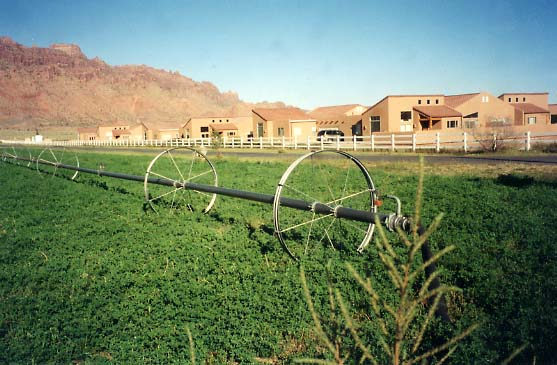

Throughout the Quivira Coalitionís annual conference in the Albuquerque Hilton, I'd been scribbling: cowboy hat inventories, notes for friends in environmental groups, and unpainted opinions about what the ranchers were saying. Griping in the notebook calmed me when the "win-win" language and talk of beneficial hoof action got thick.
The theme of bringing environmentalists and ranchers together surfaced regularly, though most of the 300 assembled were ranchers (about 100) or agency staffers. Collaboration and diversity look great on promotional materials. But would Quivira still want diversity if it came with real differences?
Well, one person apparently did. Halfway through the last session, a cowboy sat down next to me. No pleasantries, really, except for a compliment on a point I'd raised and a moment for me to survey him from his Deseret Land & Livestock cap to his worn, handsome boots.
"You've been taking a lot of notes."
"I have a bad memory."
"Mind if I read them?"
"What?!"
I thought of the hat inventories. How embarrassing. And what if he thought I stood for environmentalists? I don't have kids or a car and I eat organic food, but I donít represent anything. I came to the conference out of curiosity, hoping that the Quivira people might be plainspoken, land-loving anomalies in the rangeland conflict.
Well, what the hell. I handed him the notebook.
Cowboy Hats: 2 brown, 3 black, 2 tan, 3 ivory, 1 gray .. . .
Rick Knight: "It is darned hard to start a conversation on private land in the West"... Most stunning thing that 300 rural folks can sit butt-to-butt in the Hilton ballroom.
The cowboy sat next to me and read all 49 tiny pages.
We've corresponded since---I e-mail questions or rants and he answers patiently. Turns out he's an avid birder and has published in Nature. You can't judge a man by his hat, especially at a Quivira Coalition meeting.
The nonprofit coalition formed five years ago in Santa Fe to spread the word, inside and outside of the ranching community, that ecologically healthy rangeland and economically robust ranches can be compatible. They also set out to define the core issues of the grazing conflict and articulate a new position based on "common interests and common sense."
Where would we find common sense, though, within a population---all of us in the West---that paid scarce little attention to the land before massively altering it. We've changed the West so radically-from the monocrop soy in the Dakotas to the poisonous vegetable farms of the Bakersfield Valley, from the trashed ranches of Arizona to the nine dams on the Columbia. We don't have a clue what "healthy" looks like. Is there even potential for "common sense," or are we only working with base common interests?
"We need a vocabulary for talking to each other about the ground below our feet," says Courtney White, the Coalition's personable, pragmatic executive director. "We have to find a common language." The Journal of Range Management (V55:584-597) suggests three attributes to look for---soil and site stability, hydrologic function, and biotic integrity-echoing Aldo Leopold's advice that "[a] thing is right when it tends to preserve the integrity, stability and beauty of the biotic system. It is wrong when it tends otherwise."
Bill McDonald put the stakes bluntly: "What's being lost in the rhetoric is the only thing that matters-the eventual consequences for the land." McDonald, the first rancher to win a MacArthur Foundation "Genius" Fellowship, directs the Malpai Borderlands Group, an eclectic collaborative that works with a chunk of land including the famous Gray Ranch. The conference crowd burst into applause when he quipped, "We talk about how hard it is for ranchers and environmentalists to work together. What's really hard is to get one rancher to work with another rancher." Approving nods met his next admonition, that "there is a fear to let scientists and researchers on your ranch that we've got to overcome."
Some of the ranchers at the conference have beaten that fear, hosting Audubon bird counts on their land and inviting scientists to help assess their successes and failures. Environmentalists have a lot to offer ranchers. It's always so humbling to walk with a good birder or an entomologist or a painter or anyone other than your own damn self in a place you thought you knew like the back of your hand.
At the ultra-basic level of "common interests," ranchers talk to environmentalists partly to help maintain their access to public lands. Environmentalists talk to ranchers because they're more receptive to discussion about private land than, say, gated-community or trailer park developers. But some of the most potentially helpful environmentalists aren't talking.
The Quivira Coalition isn't working with "extreme" environmentalists or "hard-core" ranchers. In an April 5, 2003 interview with the Arizona Daily Star, White said that groups like the Center for Biological Diversity (CBD) didn't get invitations to a recent workshop because "we try not to change the minds of the extremes."
A discussion of the future of ranching without CBD present is like a western ecosystem without wolves. CBD has shaped ranching. Its publicity and litigation have secured protection for 288 species and 38 million acres of critical habitat. The CBD speaks in no uncertain terms: "In the Southwest, livestock grazing is the most widespread cause of species endangerment, affecting 15 of 27 federally listed threatened or endangered species. In dry regions, grazing wreaks catastrophic destruction on rivers, deserts, grasslands and forests over large areas." CBD "will continue to appeal permits that allow cattle to graze on public lands harboring rare and imperiled species..."
At a session break, I asked rancher Lyle Dethlefson what he thought of CBD. He surprised me by saying that if it wasn't for the Center, ranchers might not have had to find better ways to work. Some ranchers now include recovery of biodiversity in their goals. They'll have environmentalists to thank, in part, for successes. Environmental groups have worked hard to protect the high country and streams that feed valley-bottom ranches.
So I asked White why the Quivira Coalition didn't make more of an effort to attract CBD participation.
"Why go beat on their doors?" he said. "I'm not trying to mediate the extremes-you can spend a lot of time and energy trying to pry open closed minds. Some folks are so heavily invested in their positions...I'd rather work with people who are eager to do things differently."
"That said, let me make it clear that we're not exclusive. We will accept anyone. I'm just not going to try to change their minds."
While eco-fundamentalists may dismiss groups trying sustainable grazing---from the tiny Malpai Borderlands Group to the titan Nature Conservancy---as too "wise use," Big Ranching dismisses them as way too green. I asked my friend Steve Capra of the New Mexico Wilderness Alliance if his collaborations with ranchers had earned him points with anti-conservation legislators. He laughed and told me that Representative Steve Pearce asked for names when he mentioned that he had ranchers working with him on the protection of Otero Mesa.
"Those guys are fringe" was the summary dismissal.
Whether the "alternative ranchers" are outcasts or icons, environmentalists might consider getting in on the ground floor; alternative management is starting to change the land.
Quivira's recommended method, specifically, is not necessarily low impact. The Coalition calls its "New Ranch" and lays it out in The New Ranch Handbook, available to anyone for ten bucks plus tax from quiviracoalition.org. Essentially, the method asks ranchers to know the land, control their animals, and work according to goals. Ranchers learn and monitor community biological dynamics and water, energy and mineral cycles. They keep cows out of riparian areas during the growing season. Rather than let cattle roam, they herd and fence them into a tight group that will eat an area down to stubble and then stay out until it's had time to regenerate. In a system known as grassbanking, cows move between ranches to rest damaged land. Several ranches have seen dramatic increases in grass production using New Ranch methods, but they might not be for everyone.
"It's all pretty new up here in Utah," says Roger Barton, who organized the Utah Range Coalition last year. He praises the successes of New Ranch methods near Paonia, Colorado, but wonders how they'll work in southern Utah. He and the URC invited the Quivira Coalition to lead a workshop in Moab last December.
"I felt that it was time to bring them up here. I work with the Soil Conservation Service, and I can see that the ranchers up here can improve their range...They've got some really innovative ideas."
Amost 150 people came, about half of them ranchers. The URC didn't get much attendance from environmental groups, but at least, Roger said, "we've got a member of the Sierra Club sits on our board, and it's been really good to have him."
They talked about New Ranch methods, community partnerships, and grazing as a tool to revitalize local mine sites. "It was wonderful," Barton recalled. But he's looking to work even more specifically with local ecosystems.
"I still keep in close contact with Courtney White, but I decided it was time to wean myself from [the Quivira Coalition] a little, work out our own thing up here. We're kind of riding on their coattails. Where they have successes, we'll try the same thing, and where they fail, we'll avoid that."
There's a smorgasbord of new practices to sample, aside from New Ranch. Ranchers are going organic, natural (no additives), grass-fed, and "wolf-friendly" (no predator killing). Meat couldn't legally be labeled "organic" until 1999, and permanent organic standards for meat didn't go into effect until late last year. Organic ranching has surged. More than fifteen thousand certified organic beef cows roamed 27 states by 2001 (Economic Research Service, USDA AIB-780). The number of sheep and lambs raised organically has increased fivefold in five years. More than a million acres of pasture were certified organic by 2001, concentrated in Texas, Colorado and Montana.
Ranchers are stubborn about staying on the land, but family ranchers have to be flexible to make it pay. They're diversifying income with grants to protect open space, water resources, or sensitive species. Some earn the bulk of their income through guest operations and hunting, fishing, and hiking clubs. They're niche-marketing to chef's collaboratives, farmer's markets, and natural food stores. Some collaboratives have trademarks with endorsements from groups like the Nature Conservancy.
Even notorious predator-control practices are changing. To cut predator losses, some ranchers are increasing herding or bonding cows and sheep with each other and with guard dogs. Duke Phillips described predator control methods for his Beefmaster Cattle, a variety raised to match its environment: if a cow loses her calf to a coyote, he culls the cow.
Ranchers have lower-impact options for improving the vitality of their range. Speakers at the Quivira Coalition's annual conference shared success stories, all big on elbow grease and small on diesel. Some were even accomplished with volunteers from environmental groups.
Speaker Bill Zeedyk encouraged, "there's lots of opportunities to restore the land relatively cheaply if you pay attention to ecology and hydrology." For $700, he'd raised a culvert thirty inches to rewet 25 acres of historic wetland. He'd restored curves to bulldozed creeks with loose, one-rock-high dams and sticks driven into incipient point bars to catch flood debris. Sherri Tippie showed how to rewet wetlands by reintroducing beavers, which she did for the first few years by carrying them in her arms and the back of her Honda. Lanni Malmberg, "the gypsy goat lady," showed how her cashmere goats routed tamarisk stands and swaths of weeds that herbicides couldn't touch. Better yet, her tightly herded goats left behind fertilizer and tilled dirt for the native seeds Lanni planted. Tony and Jerrie Tipton used the same method, called "poop and stomp," to revitalize mine tailings and leach pits, scattering good hay over the hardpan to keep their cows moving.
Can these methods maintain the integrity and stability of the biotic system? We'll find out, if the land stays in production. White sees hope in the results at Jornada Experimental Range and several demonstration projects. But he admits, "The research isn't really there yet." His words move me---on a topic dominated by people who are 100% right 100% of the time, it's a pleasure to hear some uncertainty.
Ranchers have a lot in common with environmentalists; the lines between us have blurred. We love open space and animals and...we all want the same land. Speaker and C.S.U. scientist Rick Knight detailed the characteristics of prime ranchland: access to large areas of public land, perennial streams, and habitat and plant diversity-the same characteristics that define outstanding wildlife corridor potential. Add nearby cities or airstrips, and you've got the characteristics that define prime real estate.
In times like these, when nonprofits are going through terrible hardship and the government seems decidedly cool toward public input, it's tempting for environmentalists to settle back into pure litigation. But perhaps it's a triumph of democracy to keep blurring the lines. Wouldn't it be fun if the next time a government administration cut public input short, those who stood to benefit said, "Sorry, but we don't work that way. We're happy to listen."
Well, we can dream. And here's a kiss to build the dream on: the Quivira Coalition's "Invitation to Join the Radical Center" (printed on this page).
The first two-thirds of the "Invitation" portray the West in a disaster state due to polarized politics, unchecked development, poor land management, and bad ranching. Given that better ranch methods are available, the invitation itself follows: "As a consequence of these crises and trends we believe it is time to cease hostilities and enter a new era of cooperation."
I have just one bone to pick. Seven more belief statements follow the invitation sentence, broken only by "we know" statements. Why believe? Why not think? We have no ground, at this point, to claim certainty. Why not say, "We think that much of the West can be grazed in an ecologically sound manner"---and then set ourselves to finding out if it's true.
It's an intriguing invitation. If they have the bravery to accept their own challenge, this unlikely group of ranchers could lead us to a new way of thinking and talking in the West, or, better yet, inspire a diaspora of local collaboratives focused on local ecosystems.
During the conference, I got irate over some comment and stepped out for some fresh air. I got a dose of reality instead. I can't even remember the names of the businesses I walked by---Cost-Plus or Cost-Cutters or Costco? Denny's or Furr's or Luby's? Sunshine glared off freeway embankments, drowned in the smoke of frontage traffic. Apparently no one walked here-drivers honked and stared at me.
The place I walked was recently sparsely occupied, beautiful desert; it had been transformed into this inhumane, inanimate place step by preventable step, purchase by purchase. Much rural land has also lost liveliness, with bare ground, disappearing streams, and scattershot development. Looking at the way we live, I wonder how much any of us really values land. Maybe we just say we love the land to lay claim to it or justify frivolous fighting. Or maybe we have potential to live up to our love.
If we want to fit ourselves and our farms and ranches into western ecosystems, we're going to have to look at the ground together for once, develop that common language, imagine ourselves here, with each other in this place, forever. We'll have to risk it, like that cowboy did on the last day of the conference, and talk with people who donít think, talk, or, god forbid, dress like us.
We need fewer hats and more heads involved.








